Danny’s 3rd year research for the Crawford College of Art and Design.
Don't wanna be here? Send us removal request.
Text
The Landscape, Ecology & Environment Research Residencies is a biannual project initiated at Leitrim Sculpture Centre during 2020. Now in its third rendition the programme provides artists with a wide range of supports for the development of new engagements with landscape, ecology and/or environmental contexts and themes and to develop from this work, new directions, approaches and methodologies within their own practice. Alongside an exhibition of art works in various mediums during June 2024 artists will also included research portfolio’s that afford a unique perspective on to the different processes and orientations of their practice.
Artists and Projects participating in the LEER 2023/24 research residencies include:
Tim Collins and Reiko Goto
Vanya Lambrecht Ward
Marielle Maclennan
Noah Rose
1 note
·
View note
Text
Independent research-based visual artist attending to complex environmental issues iterated through a range of site-specific and socially engaged contexts. Conceptually and physically pursued through the subject of the seed and the agency of plant matter mediated and assembled through a range of material processes and seasonal actions. Here seeds are defined not as a thing, but as a set of social relations that must be continually cultivated to survive, grow, adapt and evolve. She digs, draws, plants, collects, mulches, narrates and ‘care’ for ‘other’ beings in ‘other’ spaces in response to our anthropogenic times. Variable and multimodal processes that parallel the labouring activities of the ‘gardener’. Through this eclectic and microscopic lens the entangled narratives and often antagonistic relationship between human and non-human species are made manifest across multiple forms. The evolving projects, public engagements, publications and exhibitions are meticulously researched, pursue a narrative structure based on an assemblage of key research material, sites of interest and social integration. This generative approach attempts to activate new ideas related to site, agency and ecology.
Christine Mackey, Plant Pigment (Installation), LSC, 2021
Christine Mackey, Plant Pigment (Installation), LSC, 2021
Christine Mackey, The Long Field, Used Polaroids, LSC, 2021
Christine Mackey, The Long Field, Used Polaroids, LSC, 2021
Christine Mackey, Plant Pigment (Installation), LSC, 2021
Christine Mackey, Plant Pigment (Installation), LSC, 2021
Christine Mackey, Charcoal Drawing with Seed Box, LSC, 2021
Christine Mackey, Charcoal Drawing with Seed Box, LSC, 2021
Christiine Mackey, Hedgerow Wall, LSC, 2021
Christiine Mackey, Hedgerow Wall, LSC, 2021
Christine Mackey, The Long Field (installation view), LSC, 2021
Christine Mackey, The Long Field (installation view), LSC, 2021
Christine Mackey, Seed Box (installation), LSC, 2021
Christine Mackey, Seed Box (installation), LSC, 2021
Christine Mackey, Microlandscape, LSC, 2021
Christine Mackey, Microlandscape, LSC, 2021
Christine Mackey
Completed the first iteration of ‘The Long Field’ (2021) at The Leitrim Sculpture Centre awarded through their Solo Residency Exhibition programme. Held Solo exhibition 'Safe Hold' at the Wexford Arts Centre, which also involved a socially engaged public art and educational project through Wexford County Council (2020). Developed new work for Two person Show/Residency 'SHUL' at Tipperary Arts Centre and participated on the Woods Research Residency at INTERFACE, Galway (2021). Recent awards include the Agility Award Round 3. and bursary from Leitrim County Council Arts Awards (2021). Invited to exhibit CITY Highlands Gallery Drogheda’s Municipal Art Gallery (2021). Alumni Fulbright Research Scholar (2018) and graduate of the University of Ulster with a practice-based PhD (2012). Published new work in PVA Journal Vol. 13. Residencies for 2022 include, EcoShowBoat, Cill Rialaig and Cow House Studios, Wexford. On-going projects include ‘The Potting Shed’ (2013 -) ArtLink, Donegal, which opened up a new social space and garden inside a defunct military environment; addressing pressing environmental issues in relation to the geopolitical control of seeds was made evident in ‘Seed Matter’ (2010-) devised as a series of exhibitions and a publication, with future works currently in development.
1 note
·
View note
Text
Human and non-human lives are inextricably linked in a welter of being. The artists and scholars in this issue engage the comedies, tragedies, surprises, and satisfactions of interspecies communication, broadly defined. Energizing our connections with others through conscious communication seems irresistible to humans, as social primates. Likewise, non-human creatures enter the communicative exchange through vocalization, gesture, touch, and non-verbal cues. From art projects that imagine interspecies dialogues, to lab experiments that produce rhizomatic, non-hierarchical forms of knowledge, to attempts to connect with microbes or alien life, the works presented here enliven human understanding of interspecies discourse. Drawing on art, animal studies, anthropology, architecture, art history, bioethics, game studies, neuroscience, philosophy, psychology, robotics, and technology studies, this special issue of PUBLIC considers the negotiation of information exchange among different forms of embodiment.

1 note
·
View note
Text
youtube
ILEA TALKS 2022:
"Learning from the Earth"
Responding to the times of planetary crisis caused by the effects of extractive, racial and colonial capitalism, the symposium Learning from the Earth aims to bring us closer to our planet to forge modes of learning from the Earth, including these alternative—at times unlearned or forgotten—ways of listening to other earthly beings. Gathering fourteen speakers representing various perspectives, specialisms, and approaches, the symposium addresses issues of sustainability, biodiversity, the human-animal-plant hierarchy, holism, cosmology, and nature(culture). It asks, what should be learned, and unlearned, in order to create a more ecologically just future and how can artistic practice contribute to these processes? The symposium’s speakers will present contributions that are both commentaries and proposals critically examining the present and suggesting alternatives to the current planetary developments.
KEYNOTES: Ursula Biemann / T.J. Demos / Fernando Garcia-Dory
LECTURES: Ravi Agarwal / Annemarie Bucher / Damian Christinger / Anne-Laure Franchette / Johannes M. Hedinger / Hanna B. Hölling / Catherine Hug / Marcus Maeder / Martin Ott / Dharmendra Prasad / Shazeb Shaikh
1 note
·
View note
Text
1 note
·
View note
Text

CMUK
CMUK is an interspecies collective that was established in 2014 by the grey parrots Clara and Karl and the artists Ute Hörner and Mathias Antlfinger. The collaborative project of parrots and humans promotes the decentralization of “human animals” as superior creators and opens up the perspective towards an overwhelming productivity by a non-human agency. CMUK works and plays in a transmedia manner, using a variety of materials, processes and contexts. Subtraction, décollage and all sorts of destruction are part of the sculptors’ repertoire. The word CMUK is an acronym composed of the forenames of the founding members: Clara, Mathias, Ute and Karl. It means something like “a little kiss” in Slovene.
2 notes
·
View notes
Text










Readings from whitechapel documents of contemporary art book on nature, edited by Jeffery Kastner. All the writings I have read involving animals.
#contemporary art#fine art#art and ecology#ecology#whitechapel gallery documents on contemporary art
0 notes
Text
Brian Maguire expressionist paintings address issues of social injustice and malfunction. He has worked with marginalised groups in institutions in Ireland, Poland and the US. Maguire represented Ireland at the São Paolo Biennale in 1998. He was appointed Professor of the Fine Art Faculty of the National College of Art and Design in 2000 and is an elected member of Aosdána.
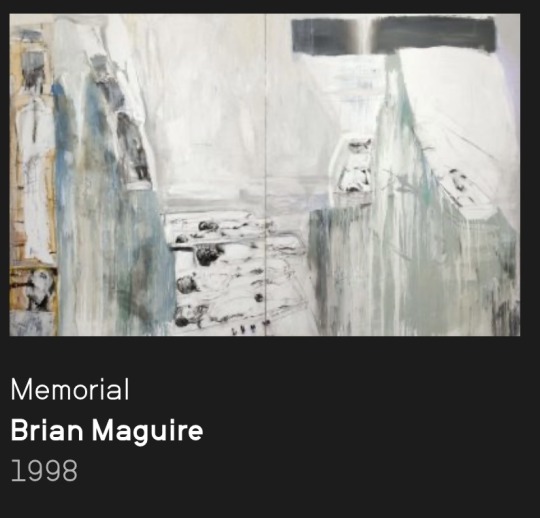
https://crawfordartgallery.ie/remains-brian-maguire/
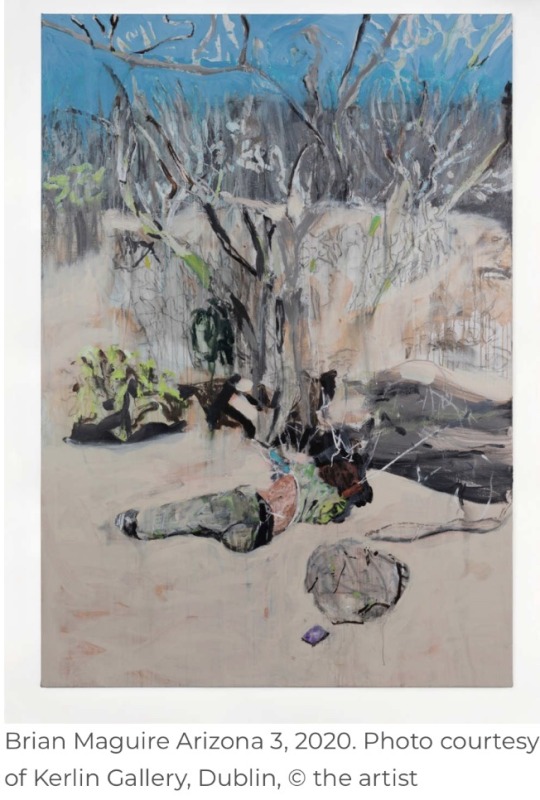
In 2019, Brian Maguire visited Dr Greg Hess, Chief Medical Examiner for Pima County, Tucson, Arizona. Dr Hess gave the artist access to some thousand visual records of migrant lives lost in the crossing from South and Central America and Mexico, into the United States.
Each discovery of a body in the desert creates a case and digital images. Using a selection from this photographic source, Brian began a new series of paintings, acknowledging the many unidentified victims who undertook this perilous journey.
In explaining his process in creating memorial works Maguire has said: “for the Juarez Femicides series I used the family photograph as an image upon which to base the commemorative painting. The mothers of deceased women and girls recognize that the portrait remembers their children as they, the mothers, remember their children.” Elaborating on Arizona, he says: “This project is different in that it is the death I record or memorialise. No family would like to retain this image of a loved one, except as needed by a process of seeking justice. My work since 1997 has become increasingly focused on lives lost, often with a political perspective on the event of the loss.”
Maguire’s most recent bodies of work directly confront issues of migration, displacement and human dignity in the face of the current global unrest. They are some of his most nuanced and ambitious to date, which he has crafted with larger brushes and thinned-down acrylic on canvas.
The exhibition features a short collaborative film Brian made with Mark McLoughlin of bangbangteo, an independent documentary production company. Previous collaborations between Brian Maguire and bangbangteoinclude the film BLOOD RISING, which focused on communicating stories of brutal femicide in Juarez, Mexico. The film, Remains - Brian Maguire, offers a window into the artist’s working methods and his motivations. Brian is filmed in conversation with people intimate with the complexities of life at the US/Mexican border.
Maguire has shown extensively in Europe and the US, most recently at the Museo De Arte de Ciudad Juarez, Mexico and the Rubin Centre, Texas University at El Paso, Texas (September 2019), at the United Nations Headquarters, New York, (in 2020), the Rhona Hoffmann Gallery, Chicago, (January 2021), and Galerie Christophe Gaillard, Paris (March 2021).
#Brian Maguire#painting#irish painter#contemporary art#fine art#borders#political art#social injustice#contemporary painting
1 note
·
View note
Text
Dr. Stacy Alaimo
(she/they)
Professor of English, Director of Graduate Studies for English;
Core Faculty Member, Environmental Studies;
COLT Participating Faculty; CSWS Faculty Affiliate
University of Oregon
I write about the strange and often volatile relations between environmentalism, science, theory, literature, art, popular culture, and gender. My concept of trans-corporeality links material feminism, new materialism, environmental justice, and environmental posthumanism. While my first three books build one coherent theoretical argument, my recent work turns to ocean life, developing the "blue" or oceanic humanities along with marine science studies.
Current Project:
The Abyss at Hand: Aesthetic Encounters in the Science, Art, and Literature of Deep Sea Creatures.
This book investigates the science, art, film, science fiction, and science writing about deep sea creatures, from the work of William Beebe and Else Bostelmann in the 1930s to the Census of Marine Life, which concluded in 2010. It investigates how aesthetic recognition of deep sea creatures scrambles scientific epistemologies and expands the terrain of environmental concern. I grapple with colonialist global visions, critique white masculinist narratives of exploration, analyze the categories of the surreal, weird, and alien; and swirl together emerging theories and methods in the blue humanities, while suggesting a more fluid and potent sense of the aesthetic. As the threats to ocean ecologies accelerate and the deep seas receive scientific, popular, and political attention, I hope this book will incite more discussion of the abyss at hand.
Exposed: Environmental Politics and Pleasures in Posthuman Times (Minnesota 2016) contends that the anthropocene is no time to set things straight. The book resists the temptation to engage in any sort of grand mapping that would be inimical to the embedded modes of epistemological, ethical, and political engagement that it traces, working instead through a surprising mix of theory, science, art, and activism. It begins by considering the pleasures of inhabiting places where the domestic refuses to domesticate and the walls decline to divide. It ends with an imaginary inhabitation of the dissolving shells of sea creatures who epitomize extinction in anthropocene seas. Along the way it considers queer animals, naked protests, the strange agencies of plastic pollution, and the gendered politics of climate change. Dwelling in the dissolve, where fundamental boundaries have begun to come undone, unraveled by unknown futures, can be a mode of ethical engagement and political inhabitation, which emanates from both feminist and environmentalist practices. Exposed locates new materialisms and material feminisms in fleeting ethical moments and compromised political sites that make up the massive temporal and geographical expanse of the anthropocene.[Cover art: Marina Zurkow, video still from "Slurb."]
Italian translation, published by Mimesis, 2023.
Korean translation, translated by Myung-Joo Kim, Chungnam National University Press, 2023.
Chapter,“Eluding Capture: The Science, Culture and Pleasure of “Queer” Animals,” translated into Greek by John Giannis/Rigas Ioannis, for a DIY activist zine, with new illustrations, 2017.
Inspired special issue of Simulacrum magazine (Amsterdam) “Practicing Exposure.” Including an interview with Max Litjens and Michelle Geraerts, 2019. http://simulacrum.nl/2019/call-for-papers-practicing-exposure-simulacrum-x-fiber-festival/
Special session, “Author Meets Readers” at the Association of American Geographers, 2018.
Podcast Interview, with Chris Richardson, This is Not a Pipe, February. 2018.https://www.tinapp.org/episodes/exposed
U of MN: Blog post: “Climate Change, Carbon-Heavy Masculinity and the Politics of Exposure” http://www.uminnpressblog.com/2016/10/climate-change-carbon-heavy-masculinity.html (October, 2016)
Culture of Energy Podcast, #39, with Cymene Howe and Dominic Boyer, Center for Energy & Environmental Research in the Human Sciences, Rice University
Podcast interview: New Books in Environmental Studies, New Books Network: Feb., 2017.
Finalist for 2017 ASLE Book Award for Ecocriticism
Bodily Natures: Science, Environment, and the Material Self (Indiana UP, 2010). Environmental justice, environmental health, and material feminisms occupy the "trans-corporeal" sites where body, place, and substance intersect. Bodily Natures develops my new materialist, material feminist conception of environmental thought and practice. [Cover art: "Toxic Girl," Fawazo.]
Winner of the ASLE Book Award for Ecocriticism, 2011
Featured in New Books Network interview and podcast, 2013: http://newbooksnetwork.com/stacy-alaimo-bodily-natures-science-environment-and-the-material-self-indiana-up-2010/
Plenary book session at the International Association of Environmental Philosophy, Eugene, Oregon, 2013.
Korean translation,by Joon Yun, Konkuk University, Seoul, Institute of Body and Culture, published by Greenbee, as 말, 살, 흙, Word, Flesh, Dirt, 2018; second printing, 2018.
Chapters translated into Portuguese, Spanish, Polish,
Key concept, “trans-corporeality” taken up widely in humanities and social sciences, and included as an entry in Rosi Braidotti’s The Posthuman Glossary
Art exhibit, “Transcorporeality” at the Museum Ludwig, Cologne Germany, Fall 2019; published essay in catalogue, Fall 2020.
Undomesticated Ground: Recasting Nature as Feminist Space (Cornell 2000) Written during a time when academic theory spurned the concept of "nature," this book delves into the negative discursive histories of that term, while posing more positive visions for feminist environmentalisms. By drawing on poststructuralist feminist theory and cultural studies, I advocate gender-minimizing, queer, intersectional feminisms that recast nature as feminist space. Darwinian feminists, Marxist feminists, birth control activists, postmodern artists and novelists, and queer writers reinvent the concept of "nature," contending that culture, not "nature" is the ground of essentialism and gender normatively. [Cover art: Ana Mendieta.]
Excerpts on “Mother Earth” reprinted in Nuda Paper(commercial paper sold in Stockholm, Paris, Berlin, and London), Fall 2019.
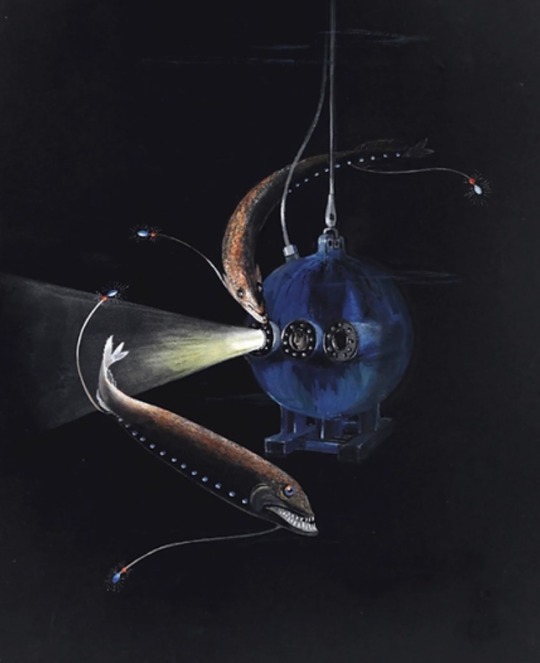
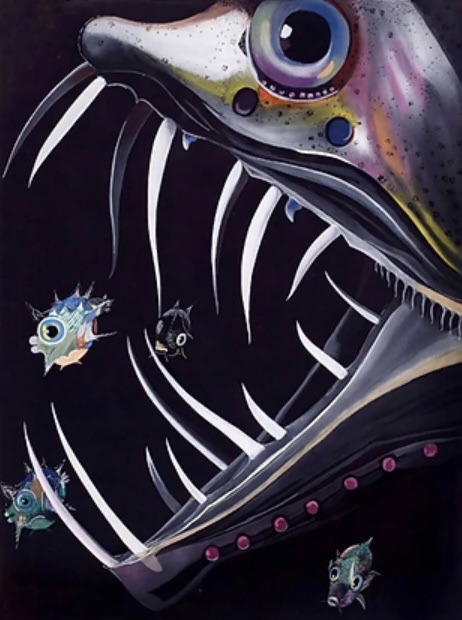
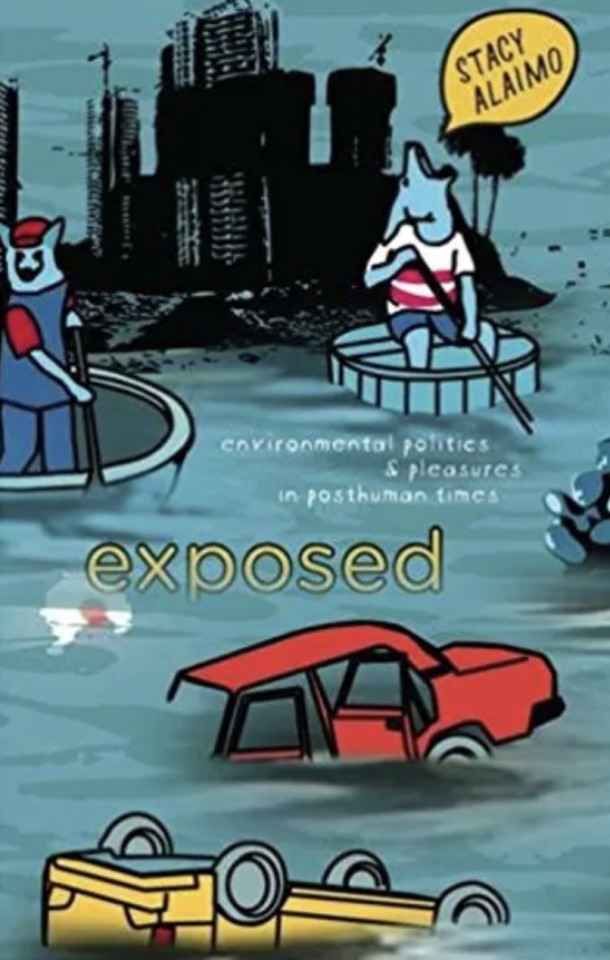
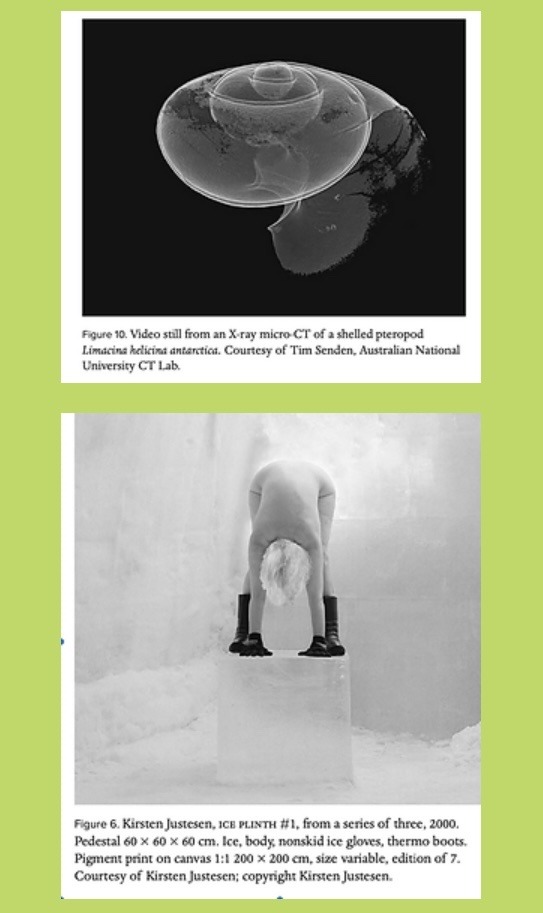
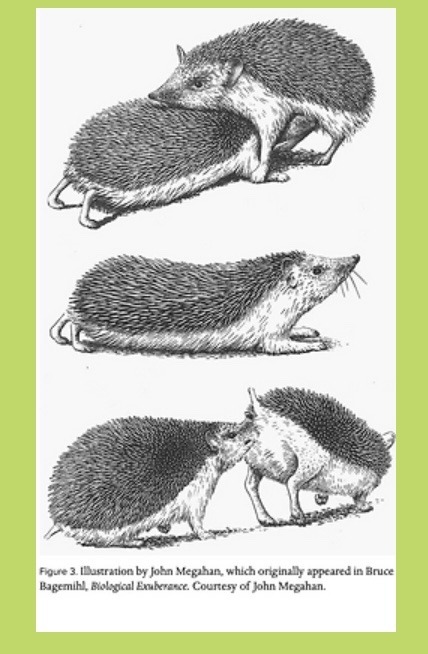
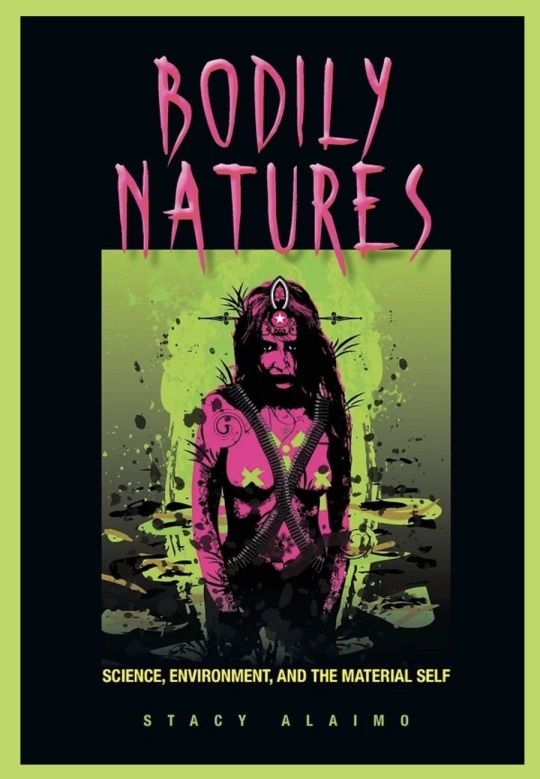
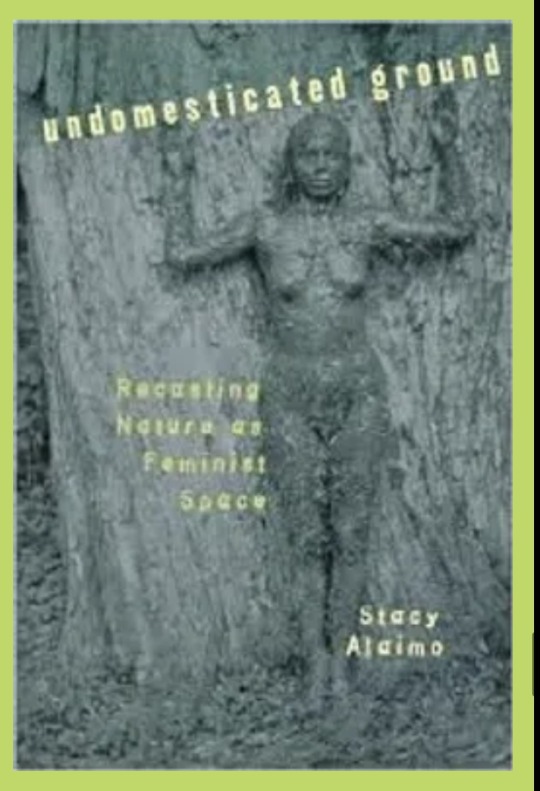
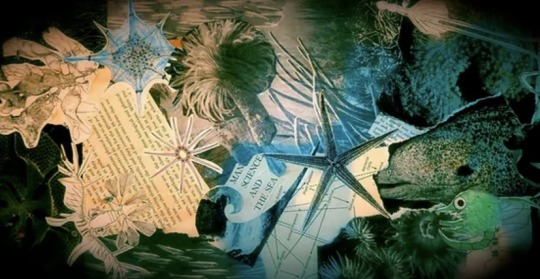
#Stacy Alaimo#post-humanism#ocean ecologies#art and ecology#ecology#science and art#queer animals#climate change#gendered politics#anthropocene
3 notes
·
View notes
Text
Communication: We are not the only ones talking… Uillinn West Cork Arts Centre, Ireland

The opening event, featured a gallery conversation between the artist and Seán Kissane, Curator of Exhibitions at IMMA.
Focusing on his expanded film Communication: We Are Not The Only Ones Talking... the exhibition, which includes new installation works for Uillinn, explores languages in other species on Earth. Bolster grapples with the possibilities inherent in the discovery of syntax in other non-human species based on information theory and with the philosophical implications ensuing from the discovery of life on other planets.
The tapestry room piece featured above is the Impermanence of Protection: Big Bend National Park (2023) It takes the form of a panorama, these were popular as vehicles of wonder, often shown in cities throughout the 19th century to immerse people in the sublime. The landscape depicted within the piece is Big Bend National Park, a park like many that was at risk of change in the Trump era. This is an image of the border between Mexico and America, ranchers and farmers cross this boundary each day to look after their livestock. Bolster immortalizes the image of the type of uninterrupted nature that many of us will see disappear during our lifetimes, if they are not properly cared for through legislation.

0 notes
Text
Shannon Alonzo is an interdisciplinary artist who I came across in the 2023 Liverpool Biennial uMoya, focusing primarily on drawing, soft sculpture and performance.
Her practice explores themes of collective belonging, place attachment, historical erasure and the significance of carnival ritual to the Caribbean consciousness.
'Mangrove' (2023)
Referencing the entangled forms of Mangroves – a group or system of trees and roots which grow in coastal, tropical climates – Alonzo has created a site-specific mural of charcoal and paint which explores the Caribbean Carnival’s relationship to space: claimed and embodied, geographic and ideological.
Like the mangroves of Trinidad, an enmeshed root system living on the fringes of land and sea, the Carnival has historically provided a place of refuge and stabilization for countless marginalised peoples. Now taking place in various countries across the world, including places which were once foreign and hostile lands, Carnival celebrations exist to resist myriad forms of racial injustice and institutionalized oppression; a space for people of the Caribbean diaspora to assert their right to joy, self-articulation, agency, dignity, and ancestral legacy.
The motif of the Mangrove also pays homage to Frank Crichlow, a community activist and civil rights campaigner who became known as the ‘Godfather of Black Radicalism’ in London in 1960’s. Crichlow owned the infamous Mangrove Restaurant – a space of refuge for activists and creatives of the Windrush generation in Notting Hill, which also served as the informal head office for the Carnival.
Central to the mural is Elma Francois, a little known but revolutionary figure who began her journey picking cotton alongside her mother at an early age. The poor treatment she witnessed sparked her interest in workers’ rights, leading her to become a leader in critical labour movements of the1930’s in Trinidad, which spread throughout the Caribbean. Here, she claims space in the Cotton Exchange Building, bringing a divine feminine energy to a formerly male environment, driven by capitalist ideology. Her presence, alongside Alonzo’s ritual of erasing and redrawing the mural part way through the exhibition, is an offering to catalyse healing and a restoration of balance. Figures within the mural blur in and out of focus, acting as a nod to rhythm and movement but also emphasising the fragility of histories which are passed on through oral or performance storytelling. In places, it is difficult to tell where the figures end and the Mangrove begins







#Shannon Alonzo#liverpoolbienial#umoya#charcoal#mural#drawing installation#expanded drawing#fine art#contemporary art#installation#soft sculpture#diaspora#mangroves
1 note
·
View note
Text
Why do humans make art? When did we begin to make our mark on the world? And where? In this film, Britain's most celebrated sculptor Antony Gormley is setting out on a journey to see for himself the very beginnings of art.
Once we believed that art began with the cave paintings of Ice Age Europe, tens of thousands of years ago. But now, extraordinary new
discoveries around the world are overturning that idea. Antony is going to travel across the globe, and thousands of years back in time, to piece together a new story of how art began. He discovers beautiful, haunting and surprising works of art, deep inside caves across France, Spain and Indonesia, and in Australian rock shelters. He finds images created by hunter-gatherers that surprise him with their tenderness, and affinity with animals natural world. He discovers the secrets behind the techniques used by our ancestors to create these paintings. And he meets experts making discoveries that are turning the clock back on when art first began.
Finally Antony asks what these images from millennia ago can tell us - about who we are. As he says, 'If we can look closely at the art of our ancestors, perhaps we will be able to reconnect with something vital that we have lost."'.





2 notes
·
View notes
Text
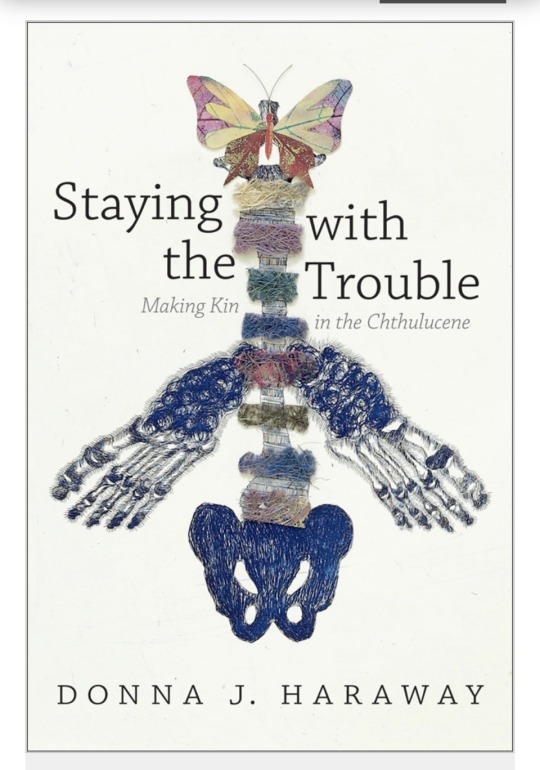
In the midst of spiraling ecological devastation, multispecies feminist theorist Donna J. Haraway offers provocative new ways to reconfigure our relations to the earth and all its inhabitants. She eschews referring to our current epoch as the Anthropocene, preferring to conceptualize it as what she calls the Chthulucene, as it more aptly and fully describes our epoch as one in which the human and nonhuman are inextricably linked in tentacular practices. The Chthulucene, Haraway explains, requires sym-poiesis, or making-with, rather than auto-poiesis, or self-making. Learning to stay with the trouble of living and dying together on a damaged earth will prove more conducive to the kind of thinking that would provide the means to building more livable futures. Theoretically and methodologically driven by the signifier SF—string figures, science fact, science fiction, speculative feminism, speculative fabulation, so far—Staying with the Trouble further cements Haraway's reputation as one of the most daring and original thinkers of our time.
#donna haraway#Donna j haraway#anthropocene#ecology#art and ecology#contemporary art#fine art#staying with the trouble#tentacular thinking
2 notes
·
View notes
Text


1 note
·
View note
Text
Peter Beard’s illustrated diaries, which he kept from a young age, evolved into a serious career as an artist and earned him a central position in the international art world.

He collaborated with Francis Bacon and Salvador Dali, made diaries with Andy Warhol, worked on books with scientists such as Dr Norman Borlaug and Alistair Graham, and toured with Truman Capote, Terry Southern, and the Rolling Stones – all of whom are brought to life in his work.

He delved into the world of fashion, taking Vogue stars like Veruschka to Africa. After spending time in Kenya and striking up a friendship with the author Isak Dinesen (Karen Blixen) in the early 1960s, Beard bought 50 acres next to her farm, with the stipulation that he would film and write about the land and its flora and fauna.
He witnessed the dawn of Kenya’s population explosion, which challenged finite resources and stressed animal populations – including the starving elephants of Tsavo dying by the tens of thousands in a wasteland of eaten trees. So he documented what he saw – with diaries, photographs, and collages.
He went against the wind in publishing unique and sometimes shocking books of these works, including The End of the Game. The corpses were laid bare; the facts were carefully recorded, sometimes in type and often by hand.
Beard used his photographs as a canvas on to which he superimposed multi-layered contact sheets, ephemera, found objects, newspaper clippings that are elaborately embellished with meticulous handwriting, old-master-inspired drawings, and often swaths of animal blood used as paint.



0 notes
Text
Turner Prize: Jesse Darling wins for 'delirious' art using tattered flags and barbed wire
By Ian Youngs
Entertainment & arts reporter
5 December 2023
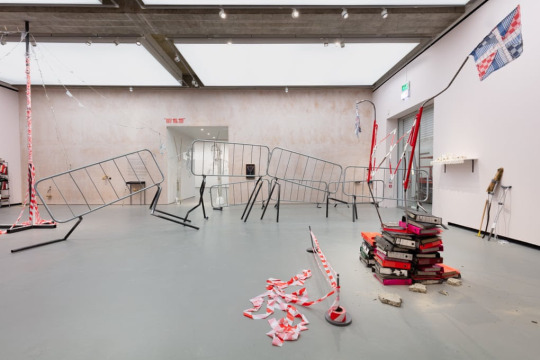
Jesse Darling's work in Turner Prize exhibition at Towner gallery in Eastbourne
Jesse Darling has given crowd control barriers legs and made them look like they are running amok
An exhibition featuring crowd control barriers that have gone out of control, twisted railway tracks, barbed wire and tattered union jack bunting - all making a comment on modern British life - has won this year's Turner Prize.
Jesse Darling picked up the prestigious art award and its £25,000 cheque at a ceremony in Eastbourne, East Sussex.
He has spoken about being inspired by his view of the effects of austerity, Brexit and the pandemic on the town, and the "hostile environment" immigration policy.

The artist says he uses objects that are cheap and easy to find, but that hold meaning for viewers
Speaking to BBC News after his win, he explained: "You have to love something to be able to critique it. I was born in this country and I'm looking at what's going on here.
"I wanted to make a work that reflected that, and I wanted to make work about Britain for the British public.
"Whether they like it or don't like it, it was a great honour and privilege to be able to do something so public for the British public."
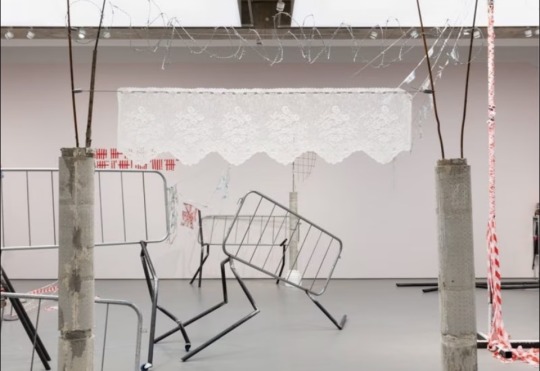
Barbed wire and a piece of net curtain hang above a crumbling mock checkpoint at the gallery entrance
The judges praised his use of common objects like barriers, hazard tape, office files and net curtains "to convey a familiar yet delirious world".
"Invoking societal breakdown, his presentation unsettles perceived notions of labour, class, Britishness and power," they said.

Darling said he would spend his prize money on dentistry and rent
The chair of the judges, Tate Britain director Alex Farquharson, added that his art was "bold", "engaging" and partly a reflection on "the state of the nation".
"It's one element of it, one layer of it. I don't think it's the whole story. There is some sense, from his point of view, that these are times of crisis."

Tattered and faded union jack bunting hangs from the ceiling
In his acceptance speech, Darling also spoke up for the power of teaching children art in schools, and said Conservative governments had sent the message that self-expression and culture were "only for particular kinds of people from particular socio-economic backgrounds".
"Don't buy in. It's for everyone," he said.
At the end of his speech, Darling pulled a Palestinian flag out of his coat pocket and waved it.
Jesse Darling was many of the critics' favourite for the prize. His room of jaunty crash barriers and union jacks is inventive and original.
Darling - who was born in Oxford but lives and works in Berlin - has said he is reflecting the hostile environment in the UK towards immigration in this work.
The exhibition entrances are turned into checkpoints complete with barbed wire. But the space itself feels alive and humorous.
That's down to the crowd control barriers Darling has sculpted at prancing angles. This is anthropomorphising writ large - the very things that are used to corral people by the police are given a life of their own, turned into creatures that can't be controlled.
We're also surrounded by frilly curtains and a maypole adorned with police tape and anti-pigeon spikes.
Darling has said British towns these days are showing the effects of austerity, Brexit and Covid. He's riffing on that in a show that tackles nationhood and British identity.
All the four nominated artists were reflecting what's happening in Britain right now. In the end, Darling was felt by the judges to be a cut above.
The other nominated artists were Ghislaine Leung, Rory Pilgrim and Barbara Walker.
The Telegraph's art critic Alastair Sooke called Darling's room at Eastbourne's Towner gallery "the most exhilarating presentation I've encountered at the annual exhibition in recent years".
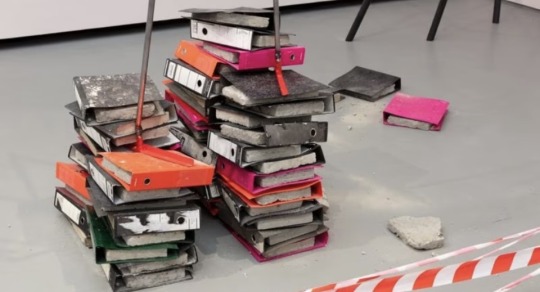
Files are filled with concrete as a comment on bureaucracy
Sooke wrote that the artist "offers an unruly vision of contemporary Britain as both ruinous and suffused with impish magic".
"Compared with such sculpturally compelling work, which boils and bubbles with brilliant ideas and touches, the offerings from the other shortlisted artists seem lukewarm."
Jesse Darling's work in Turner Prize exhibition at Towner gallery in Eastbourne
However, the Sunday Times' Waldemar Januszczak did not like Darling's entry. "I suppose it's a glumly poetic interpretation of Britain today," he wrote.
"Where it fails is in its overall visual impact. It's too bitty."
Jesse Darling's work in Turner Prize exhibition at Towner gallery in Eastbourne
Rollercoaster rails appear to crash through the gallery wall
Darling, 41, who only went to art school in his 30s, was nominated for two exhibitions in Oxford and London last year.

A cabinet contains hammers that are decorated like toys, with colourful ribbons and bells
#contemporary art#fine art#installation#sculpture#turner prize#jesse darling#brexit#borders#boundaries#political art#sculpture installation
1 note
·
View note